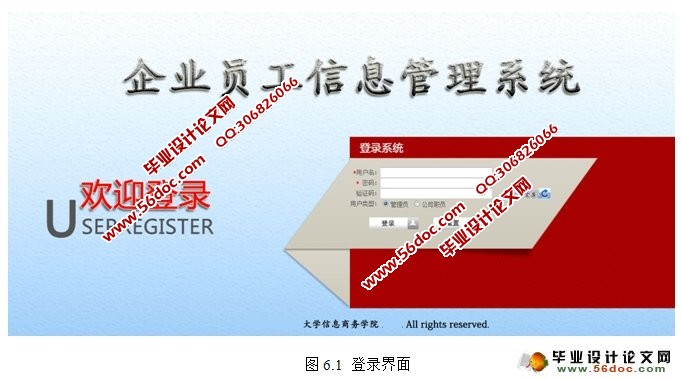企业员工信息管理系统的设计与实现(Oracle)(含录像)(任务书,开题报告,外文翻译,毕业论文16000字,程序代码,Oracle数据库,答辩PPT,答辩视频录像)
摘 要
近年来,随着计算机技术的不断发展,计算机科学日渐成熟,给人们的工作和生活带来了极大的便利和高效。信息化,电子化已经成为节约运营成本,提高工作效率的首选。
计算机作为知识经济时代的产物,已被广泛应用于社会各个行业和领域。企业员工信息管理系统软件作为一种管理软件正在各企事业单位中得到越来越广泛的应用。正是由于计算机在企业管理中应用的普及,使得利用计算机实现企业员工信息管理势在必行。企业信息化作为计算机应用的一部分,使用计算机对企业员工信息进行管理,具有着手工管理所无法比拟的优点,它能够极大地提高企业管理的效率,也是企业的科学化、正规化管理与世界接轨的重要条件。
在此系统实施过程中,采用B/S架构,使用J2EE开发框架,以统一建模语言(UML)对系统进行分析,使用STRUTS作为系统开发框架,数据库采用Oracle 10g。本系统运用现代的企业员工管理理论,并结合企业具体情况,通过分析企业员工信息管理系统的现状,设计了一个基于STRUTS+Hibernate的企业员工信息管理系统。本设计的主要内容有:员工档案管理、招聘管理、培训管理、奖惩管理、薪资管理、文件管理、系统管理。系统建立旨在将与企业员工信息管理有关的数据统一起来,形成一个统一的数据源,并能帮助企业的人事管理人员进行企业员工的管理和规划。
关键词:企业员工信息,数据库,B/S
Design Employee Information Management System is to achieve
Abstract
In recent years, with the development of computer technology, computer science increasingly mature, to the people's work and life has brought great convenience and efficiency, information technology, electronic technology has become the preferred savings in operating costs and improve efficiency.
As a product of the computer era of knowledge economy, has been widely used in various industries and areas of society. Employee information management system software as a management software is all enterprises and institutions to get more and more widely used. Because of the popularity of computer applications in enterprise management, enterprise employees make use of computer information management is imperative. Enterprise information technology as part of the computer application, the use of computer information management employees, with manual management incomparable advantages, it can greatly improve the efficiency of enterprise management, business is more scientific and standardized management, and the world important condition for convergence.
In this system, the implementation process, the use of B / S architecture using J2EE development framework for the Unified Modeling Language (UML) to analyze the system using STRUTS as a system development framework, database using Oracle 10g.The use of modern enterprise system, employee management theory, combined with the specific circumstances of the enterprise, by analyzing the current situation of employees information management system is designed based on STRUTS + Hibernate corporate employee information management system. The main contents of this paper are: employee records management, recruitment management, training management, incentive management, payroll management, file management, system management. The system is designed to establish data relating to information management employees unite to form a unified data source, and can help businesses of personnel management personnel management and planning of employees.
Keywords: corporate employee information, database, B / S
总体功能分析
功能需求定义了开发人员必须实现的软件功能,使得用户能完成他们的任务,从而满足业务需求。参照业务需求分析的结果对每个业务进行细化,从而得到系统的功能模块。
根据一般公司的员工信息管理业务需求,系统应该具有以下功能:
(1) 登录功能:为了防止非法用户的访问及信息保密性要求,登录模块应根据用户类型对其操作权限进行了限制。
(2) 企业员工信息管理:应实现企业员工信息的增加、删除、修改等操作。
(3) 招聘管理:管理员可以发布、删除招聘信息。
(4) 业务管理:根据具体的情况设置人员业务培训,可修改、删除、添加培训信息,为员工的升迁提供科学的依据。
(5) 奖惩管理:实现对奖惩信息的增加、删除等操作,为薪资、升迁等提供依据。
(6) 薪资管理:实现对员工工资的录入、查询等。
(7) 企业员工登录模块:该模块强调员工自助服务,如对个人信息、薪资等信息的查询、密码修改等操作。
(8) 系统管理模块:对该系统用户进行管理(增加、删除等)。










目 录
1 引言 1
1.1 开发背景 1
1.2 课题的目的和意义 1
1.3 课题主要研究内容 2
2 主要技术介绍 3
2.1 J2EE概述 3
2.2 J2EE的特点 3
2.3 MVC设计模式 4
2.4 Struts与Hibernate简介 5
2.4.1 Struts简介 5
2.4.2 Hibernate简介 5
2.4.3 Hibernate和Struts综合应用的系统 6
2.5 Ajax技术简介 6
2.6 B/S模式简介 7
2.7 JSP技术原理 7
3 系统开发工具及容器 9
3.1 开发工具 9
3.2 数据库的选择 9
3.3 容器 9
4 需求分析11
4.1 业务需求分析11
4.2 业务功能分析11
4.2.1 总体功能分析11
4.2.2 系统用例图11
5 系统总体设计13
5.1 系统设计的原则和目标13
5.2 系统体系结构的设计13
5.3 系统的功能模块14
5.4 数据库设计14
6 系统详细设计与实现19
6.1 模块功能设计与实现19
6.1.1 登录模块19
6.1.2 管理员模块20
6.1.3 员工档案管理模块20
6.1.4 人员招聘模块23
6.1.5 人员培训管理模块24
6.1.6 奖惩管理模块24
6.1.7 薪资管理模块26
6.1.8 文件管理模块29
7 测试30
7.1 测试重要性及目的30
7.1.1 测试重要性30
7.1.2 测试目的30
7.2 测试目标31
7.3 测试方法31
7.4 测试步骤31
7.5 本系统测试方案32
8 结论34
参考文献35
致谢36
|





















